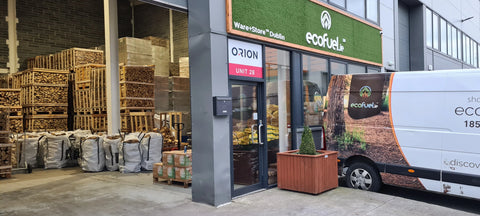On cold mornings, you can hear it before you see it. The soft click of kindling, the first breath of a flame. The world still runs on firewood.
Not the smoky, damp kind people imagine when they hear the word, but clean, intentional fires that keep homes warm in Finland, heat entire towns in Austria, and bring people together around small terraces in cities everywhere.
We live in an age of polished steel and lithium batteries, but step off the main road and the same rhythm continues: cut, stack, dry, burn, repeat.
It’s not nostalgia. It’s knowledge, one that’s being refined, not replaced.
Over the past few months, I’ve found myself drawn to stories of how people still use wood in 2025. From Finnish engineers re-designing stoves to Kenyan makers turning coconut husks into clean fuel, they all share the same idea: progress isn’t about abandoning fire, it’s about burning better.
Here’s what I’ve learned.
Finland - Precision Heat That Warms Smarter, Not More
Most Finnish detached homes keep a wood stove as backup heat, but only a minority use it as their main source. What matters is how they burn: modern Finnish masonry heaters, built from soapstone and brick, store warmth for hours and release it slowly. Airflow sensors and tight emissions standards make them remarkably efficient. What appears to be an old ritual is actually a small masterpiece of engineering.
France - A Nation That Fell Back in Love with the Wood Stove
In France, the wood stove has become part of the national identity. About 7½ million households heated with wood in the 2022/23 season, supported by state incentives like MaPrimeRénov’ that help families switch to low-emission stoves. You can walk through a village at dusk and smell beechwood in the air. A proof that comfort and responsibility can share the same chimney.

" A quiet evening in rural France, where old stone and new stoves share the same warmth "
Kenya - Turning Waste into Tomorrow’s Fuel
Across Kenya, entrepreneurs are taking agricultural waste, such as coffee shells, coconut husks, and sawdust, and pressing them into “green charcoal.” It’s a simple, local innovation that protects forests and clears the air in rural kitchens. Clean fuel, made from leftovers.
Nepal - The Power of a Simple Chimney
In Nepal’s hill villages, new chimney-hood stoves have cut household smoke exposure by roughly half, based on recent field studies. For families that once spent hours surrounded by heavy soot, the difference is life-changing: cleaner air, fewer coughs, and bright white kitchen walls where black once settled. Sometimes progress is just a better path for the smoke to leave by.
Japan - When Fire Becomes a Form of Mindfulness
In Japan, fire hasn’t lost its grace. Charcoal still warms tea houses during winter ceremonies; monks at Shinto and Buddhist temples light sacred flames each morning. The wood - hinoki, cedar, and oak are chosen with care. There’s reverence in the act, a reminder that not every fire is about heat.
Austria - Villages That Heat Themselves
Austria now produces more than half of its district heat from biomass. In alpine towns, cooperatives of forest owners operate local boiler houses that feed entire communities through underground pipes. Every cubic metre of fuel comes from nearby forests, turning thinning wood and sawmill offcuts into steady winter warmth. No hype, no offset schemes, just local energy done right.
Ireland - A Small Rule Changing How We Burn
Here in Ireland, we’re going through our own quiet transition. Under new EPA rules, all packaged firewood sold in Ireland must be 25% moisture or below, with a further tightening to 20% scheduled by regulation. The point is simple: drier wood, hotter fires, cleaner air. For most people, it’s a small change, but it means clearer skies and a national move toward quality over quantity. A small rule that changes the burn.
Canada - The Reliable Glow of the Northern Stove
In rural and northern Canada, wood remains common, especially across Atlantic provinces, Quebec, and the Yukon. Modern EPA- and CSA-certified stoves have cut particulate emissions by more than 80% compared with the ones they replaced. When a blizzard knocks out the grid, that slow-burning stove still means light, warmth, and a cup of tea. Cabin life with cleaner air and quieter confidence.
Norway - Where Stacking Wood Is a National Art
In Norway, stacking wood borders on art. The word "vedstabling" captures it: the discipline of cutting, drying, and arranging logs into perfect order. You can see it in every tidy pile outside a red farmhouse, bark-up or bark-down depending on family tradition. When NRK aired a 12-hour slow-TV broadcast of a crackling fire, one in five Norwegians tuned in. It wasn’t a joke, it was recognition.
Cities - Small Fires in Big Places
Even in cities, fire hasn’t disappeared, it’s just been redesigned. From London rooftops to Melbourne terraces, compact low-smoke firepits and ethanol burners have become modern gathering places. They’re smaller, quieter, and cleaner than the bonfires that came before. A proof that the ritual of sitting around a flame still matters, even above a skyline.
A Reflection
Everywhere you look, fire tells a different story. In one place it’s science, in another it’s survival, in another it’s ceremony. But all of them point to the same truth: when treated with respect, fire remains the most human energy we have.
We’ve learned to make it cleaner, smarter, safer. But its value hasn’t changed: connection, warmth, patience. The same things we all look for on cold days.
Next week, we’ll mark eleven winters of ECOFUEL™. A reminder that progress and care don’t have to compete.
Until then, here’s to fires burned well, and stories shared slowly.
Better Fires. Stronger Forests.





